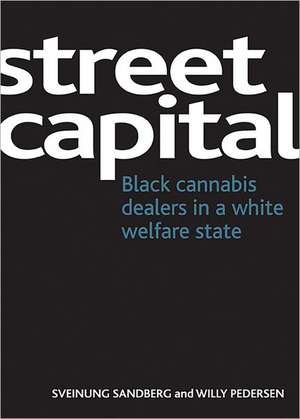Street capital – Black cannabis dealers in a white welfare state
Autor Sveinung Sandbergen Limba Engleză Hardback – 15 oct 2009
'Street capital' introduces the worlds of young black men dealing cannabis at a drug scene called The River in Oslo, Norway. The lives of these men are structured by a huge and complex cannabis economy and they are involved in fights, robberies and substance abuse. They lack jobs and education, and many of them do not have family or close friends, yet they do have 'street capital': the knowledge, skills and competence necessary to manage life on the streets.Centred on this concept of 'street capital', this unique book presents a new theoretical framework - inspired by and expanding on the work of Pierre Bourdieu, the French sociologist - for understanding street cultures. It is based on extensive fieldwork and repeated in-depth interviews with dealers aged between 15 and 30, which explore themes including marginalisation, discrimination, cannabis dealing and drug use, violence, masculinity, hip-hop culture, experiences with the welfare system, and issues of immigration and racism. The book also analyses the discursive practice of marginalised people on the street and identifies the narratives by which these young men live. 'Street capital' is aimed at postgraduates and academics in criminology, race and ethnicity, sociology, social theory and methodology. It will also be of interest to a wider social science audience, particularly those interested in using Bourdieu as a theoretical model.
Preț: 775.73 lei
Preț vechi: 1007.44 lei
-23% Nou
Puncte Express: 1164
Preț estimativ în valută:
148.47€ • 154.42$ • 124.42£
148.47€ • 154.42$ • 124.42£
Carte tipărită la comandă
Livrare economică 13-27 martie
Preluare comenzi: 021 569.72.76
Specificații
ISBN-13: 9781847421203
ISBN-10: 1847421202
Pagini: 200
Dimensiuni: 177 x 246 x 16 mm
Greutate: 0.5 kg
Ediția:New.
Editura: Bristol University Press
Locul publicării:United Kingdom
ISBN-10: 1847421202
Pagini: 200
Dimensiuni: 177 x 246 x 16 mm
Greutate: 0.5 kg
Ediția:New.
Editura: Bristol University Press
Locul publicării:United Kingdom
Recenzii
The authors offer a fascinating and clear account of the structural forces weighing upon immigrant marijuana sellers who scramble for dignity and meaning in the heart of a Nordic welfare state. They make sense of the disconcerting phenomenon of the persistence of street-based, down-and-out populations in a wealthy social democracy and offer paths out of the impasse. This sensitive ethnographic account is filled with the words of the youths themselves, revealing their search for respect in the underbelly of the Norwegian dream. Philippe Bourgois, Professor of Anthropology, University of Pennsylvania
Sandberg and Pedersen's book is a perceptive ethnographic study of a particular social world, giving a voice to multiple players in the street scene they study. Robin Room, Professor of Social Research in Alcohol, University of Melbourne
This is a book in the great tradition of studies of street-corner societies. But the arena is exceptional; a riverside in the capital of a Scandinavian welfare-state. It is an analysis sharpened by new tools that makes for new insights. Nils Christie, Professor of Criminology, University of Oslo
.....a good edition on any book shelf, specifically for those who are criminologicallyor sociologically minded or those who have an interest in Bourdieu orsubcultural theories. Theoretical Criminology
This book is informative, thought-provoking, sensitive, heart-rending in parts and, in my opinion, an outstanding work of ethnography and sociological theory. It would make an excellent teaching book - both to engage college students at the beginning of their courses by showcasing the best type of theorizing, analysis and fieldwork, and also for the teaching of qualitative methods. British Journal of Criminology
Notă biografică
Sveinung Sandberg, Department of Sociology, University of Bergen and Willy Pedersen, Department of Sociology and Human Geography, University of Oslo
Cuprins
Introduction
Trajectories to The River
Street capital
Marginalisation and resistance
Drugs and masculinity
Street dealing and drug markets
Violence and street culture
Between the street and the welfare state
Conclusion
Trajectories to The River
Street capital
Marginalisation and resistance
Drugs and masculinity
Street dealing and drug markets
Violence and street culture
Between the street and the welfare state
Conclusion
